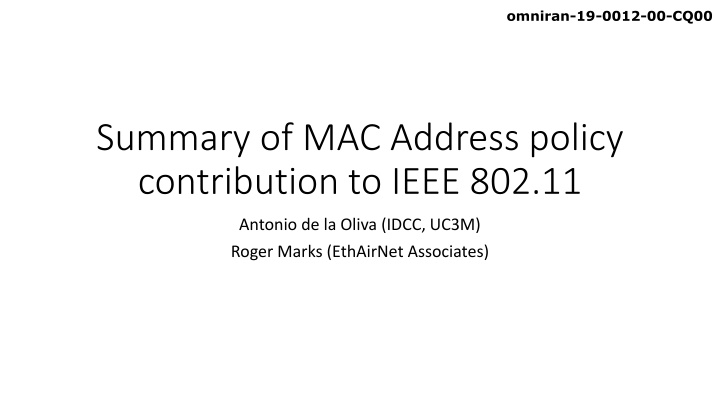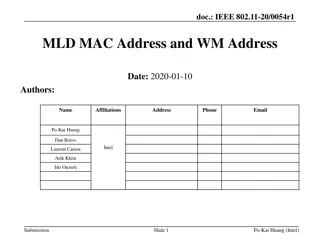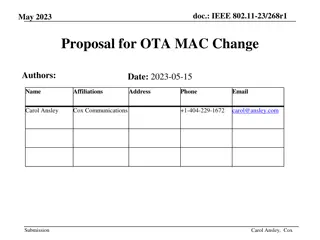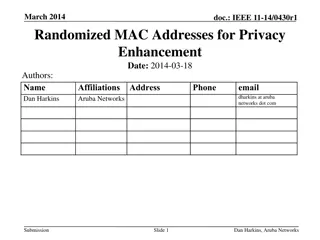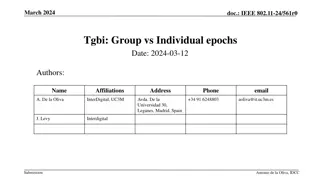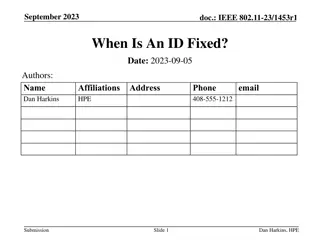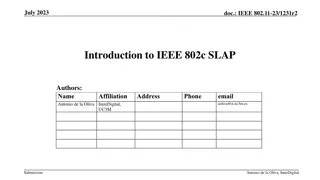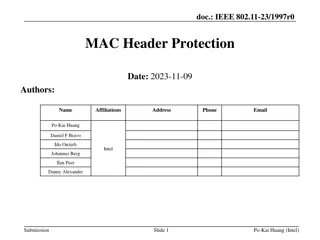Summary of MAC Address Policy Contribution to IEEE 802.11
This document outlines the contribution of MAC address policy to IEEE 802.11, focusing on defining ANQP and Beacon elements to convey information about addressing types supported by the network. It details how specific bits in the ANQP element represent support for various MAC address types including EUI, ELI, and SAI. Additionally, policy flags are defined for MAC address prefix bytes, specifying the length and trimming of the prefix. The Beacon element serves the same purpose as ANQP but excludes MAC range information to reduce beacon size.
Download Presentation

Please find below an Image/Link to download the presentation.
The content on the website is provided AS IS for your information and personal use only. It may not be sold, licensed, or shared on other websites without obtaining consent from the author.If you encounter any issues during the download, it is possible that the publisher has removed the file from their server.
You are allowed to download the files provided on this website for personal or commercial use, subject to the condition that they are used lawfully. All files are the property of their respective owners.
The content on the website is provided AS IS for your information and personal use only. It may not be sold, licensed, or shared on other websites without obtaining consent from the author.
E N D
Presentation Transcript
omniran-19-0012-00-CQ00 Summary of MAC Address policy contribution to IEEE 802.11 Antonio de la Oliva (IDCC, UC3M) Roger Marks (EthAirNet Associates)
omniran-19-0012-00-CQ00 Main ideas Define ANQP element to transport information on the kind of addressing supporting by the network Define Beacon element to transport information on the kind of addressing supported by the network
omniran-19-0012-00-CQ00 ANQP element Bit 0, when set to 1, represents the support of EUI addresses, as specified in IEEE Std 802. Bit 1, when set to 1, represents the support of ELI addresses, as specified in IEEE Std 802, incorporating IEEE Std 802c- 2017. Bit 2, when set to 1, represents the support of SAI addresses, as specified in IEEE Std 802, incorporating IEEE Std 802c- 2017. Bit 3, when set to 1, indicates the availability of a Local Adddress Assignment Protocol (LAAP) server, per IEEE Std 802.1CQ. The LAAP protocol will provide the STA with a local MAC address assignment or a set of allowed local MAC address assignments. Bit 4, when set to 1, indicates support for self-assignment, using the MAC address prefix specified in the MAC Address Prefix field. This indicates support for local addresses formed by extending the MAC address prefix to 48 bits. Bit 5 indicates that specific MAC addresses pre-configured by the administrator are supported. Bits 6-7 are reserved. MAC Address Policy MAC Address Prefix Bytes Policy Flags Info ID Length Octets: 2 2 1 1 0 6 Bitmap value Bit 0 (MSB) Bit 1 Bit 2 Bit 3 Bit 4 Bit 5 Bit 6 Bit 7 Description EUI-48 supported ELI-48 supported SAI-48 supported LAAP Server assignment Self-Assignment using specified MAC Address Prefix Pre-configured administered address Reserved Reserved
omniran-19-0012-00-CQ00 Policy Flags The Length of MAC Address Prefix Bytes subfield is a subfield of 3 bits. When the Length of MAC Address Prefix subfield is set to one of the values of 1 6, that value indicates the length (in octets) of the MAC Address Prefix Bytes field. The Length of MAC Address Prefix Bytes subfield is not set to 0 or 7; those values are reserved. The Prefix Trim subfield is a subfield of 3 bits and takes one of the values of 0 7, that value indicating number of bits to be truncated from the end of the MAC Address Prefix subfield in order to obtain the MAC Address Prefix. In other words, the MAC Address Prefix is represented as the value of the MAC Address Prefix Bytes field after truncation of some of the most significant bits of the last octet, with the number of truncated bits equal to the value of the Prefix Trim subfield. The bit and octet ordering of the MAC Address Prefix is per Figure 9-1 (Representation of a 48-bit MAC address). B0 B2 B3 B5 B6 B7 Length of MAC Address Prefix subfield (bytes) Prefix Trim subfield (bits) Reserved 3 3 2 Bits:
omniran-19-0012-00-CQ00 Beacon Element Same information as the ANQP Element Do not contain the MAC range, in order to reduce the size of the beacon Element ID Element ID Extension MAC Address Policy Length
